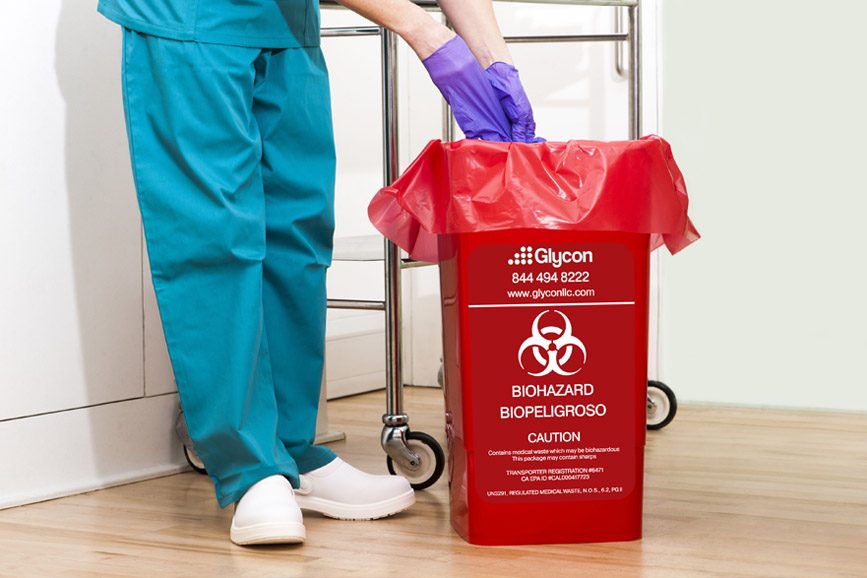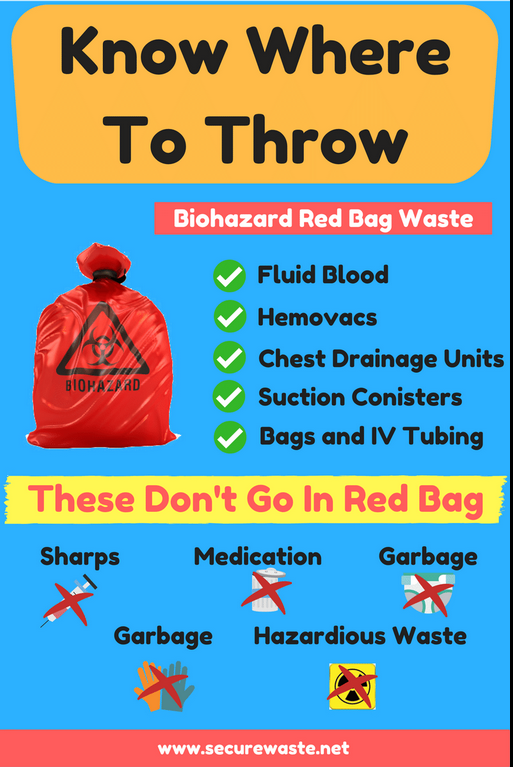Defending Wellness: Introducing the Significance of Professional Medical Waste Removal
Defending Wellness: Introducing the Significance of Professional Medical Waste Removal
Blog Article
Minimize Expenses and Make The Most Of Safety: Effective Medical Waste Disposal Strategies
Reliable medical waste disposal methods are essential for medical care centers to maximize and reduce prices safety. By carrying out proper partition and classification, efficient packaging and labeling, risk-free transport and handling, reliable therapy and disposal methods, and compliance with regulatory guidelines, healthcare centers can make certain the liable and safe monitoring of medical waste.

Proper Segregation and Classification
Correct partition and categorization are important elements of effective clinical waste disposal methods, ensuring the security of health care employees, the public, and the atmosphere - medical waste removal service. medical waste disposal services with WasteX. By dividing various sorts of medical waste at the factor of generation, healthcare centers can lessen the danger of cross-contamination and potential harm to people and ecosystems
Among the essential elements in correct partition is the recognition and classification of clinical waste. This entails classifying waste into various teams, such as infectious, hazardous, contaminated, or pharmaceutical waste. Each category calls for details handling, storage, and disposal techniques to stop any type of negative impacts on human health and the atmosphere.
Furthermore, appropriate partition also includes making use of color-coded labels and containers to plainly identify and separate the various kinds of medical waste. This aids healthcare employees and waste management employees to quickly acknowledge and deal with the waste suitably. Red containers might be utilized for transmittable waste, while yellow containers may be marked for hazardous waste.
In addition to partition, appropriate classification additionally involves the correct packaging and control of medical waste. This makes sure that waste is securely saved and moved without presenting any type of dangers to people or the setting. Utilizing puncture-resistant and watertight containers, as well as appropriately sealing and identifying them, assists to stop any kind of unexpected exposure or launch of harmful compounds.
Reliable Packaging and Identifying
Reliable packaging and labeling play a vital function in making sure the secure and effective disposal of medical waste. Correct product packaging is important to prevent leak, damage, or splilling throughout transportation and handling. It assists to reduce the risk of contamination and protects medical care employees, waste administration personnel, and the environment from possible threats.
Clinical waste needs to be packaged in leak-proof and sturdy containers that are immune to pierce and damage. These containers ought to be correctly secured to avoid any type of leakage. In addition, the packaging should have the ability to withstand the problems of transportation, consisting of temperature variations and misuse.
Labeling is just as crucial as it provides essential info concerning the materials of the waste and any potential threats connected with it. The tags ought to consist of the name of the healthcare center, the kind of waste, and any kind of special handling guidelines. Standard and clear labeling makes sure that waste management workers can conveniently determine and take care of the waste properly.
Reliable packaging and labeling likewise aid in the proper segregation and classification of medical waste. Clear labeling permits very easy identification of various waste streams, such as transmittable waste, sharps, or pharmaceutical waste. This helps in simplifying the disposal process and making sure that the waste is dealt with or thrown away based on regulatory standards.
Safe Transport and Handling
Ensuring the risk-free transport and handling of clinical waste is of utmost importance in order to avoid any kind of possible health and environmental dangers. Clinical waste, such as sharps, infected products, and pharmaceutical waste, should be appropriately packaged and taken care of to minimize the risk of exposure to dangerous materials and virus.
Transferring medical waste needs compliance with stringent guidelines and standards established by ecological firms and local authorities. These regulations aim to safeguard the health and wellness of workers included in waste administration and avoid the release of dangerous materials into the environment.
To ensure safe transport, medical waste should be positioned in leak-proof and puncture-resistant containers that are properly secured and classified. These containers must be protected in a manner that avoids spills or breakage throughout transportation (medical waste removal services). Additionally, it is essential to use customized automobiles furnished with suitable safety attributes to move clinical waste. These cars should have ample air flow and be developed to stop leak or contamination.
Handling medical waste likewise calls for proper training and adherence to safety procedures. Workers associated with the handling of clinical waste should wear suitable personal safety tools (PPE) such as handwear covers, masks, and dress to minimize the risk of exposure. They ought to likewise comply with stringent hygiene methods to stop the spread of infections and ensure the risk-free disposal of waste.
Reliable Treatment and Disposal Methods
Implementing proper therapy and disposal methods is important in handling clinical waste efficiently and lessening prospective health and wellness and environmental risks. Medical waste, which consists of sharps, transmittable products, chemicals, and drugs, can present considerable risks if not dealt with and gotten rid of correctly. There are several treatment and disposal approaches offered that stick to regulatory standards and promote safe techniques.
One typical method is incineration, which includes melting the waste at heats. Incineration is reliable in damaging virus and lowering the quantity of waste, yet it can launch unsafe pollutants into the air otherwise effectively regulated. It is vital to utilize modern incinerators equipped with exhaust control modern technologies.
One more method is autoclaving, which uses vapor and stress to disinfect the waste. Autoclaving works in killing microorganisms and lowering the quantity medical waste disposal services with WasteX of waste, but it calls for mindful tracking and maintenance to make certain proper performance. The decontaminated waste can after that be safely disposed of in a land fill.
Chemical treatment is another alternative, which includes making use of disinfectants or other chemicals to counteract microorganisms. This technique is commonly made use of for liquid waste, such as research laboratory specimens. It is important to make use of appropriate chemicals and comply with proper treatments to ensure efficient therapy and avoid ecological contamination.

Conformity With Regulatory Guidelines
Abiding by regulatory guidelines is essential in guaranteeing correct compliance with medical garbage disposal techniques. These guidelines are put in location to shield public health, avoid ecological contamination, and keep workplace security. Conformity with governing guidelines is essential for health care centers, as non-compliance can cause penalties, fines, and reputational medical waste disposal services with WasteX damage.
Regulative standards lay out the proper handling, storage, transportation, and disposal of medical waste. They offer particular directions on product packaging needs, labeling, and record-keeping. These standards also address the segregation of different waste streams, such as sharps, infectious waste, and pharmaceutical waste. Health care facilities should make sure that their waste administration methods line up with these guidelines to lessen the danger of exposure to harmful materials and avoid the spread of infections.
To maintain compliance, health care facilities should develop comprehensive waste administration programs that consist of team training, routine audits, and continuous surveillance. It is vital to maintain up-to-date with any kind of modifications or updates to governing guidelines, as methods may advance gradually. By remaining informed and applying proper procedures, healthcare facilities can decrease the potential for regulatory offenses and shield the health and wellness of their personnel, people, and the surrounding community.
Verdict
Finally, implementing effective medical waste disposal methods is critical for minimizing expenses and maximizing safety and security. Appropriate segregation and categorization, efficient packaging and labeling, safe transport and handling, and reliable treatment and disposal approaches are necessary actions to make sure conformity with regulative standards. medical waste removal near me. By sticking to these techniques, medical care centers can shield the environment and public health while also lowering monetary worries connected with medical waste administration
By executing recommended you read appropriate partition and categorization, effective product packaging and labeling, secure transport and handling, effective treatment and disposal methods, and compliance with regulatory standards, health care facilities can ensure the safe and responsible management of medical waste. Red containers may be utilized for contagious waste, while yellow containers might be marked for unsafe waste.
Standard and clear labeling makes sure that waste monitoring employees can conveniently recognize and deal with the waste appropriately. (medical waste disposal services with WasteX)
Clear labeling enables for easy recognition of different waste streams, such as transmittable waste, sharps, or pharmaceutical waste. These standards likewise address the partition of various waste streams, such as sharps, infectious waste, and pharmaceutical waste.
Report this page